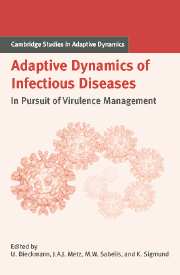Book contents
- Frontmatter
- Contents
- Contributing Authors
- List of Boxes
- Notational Standards
- 1 Introduction
- A Setting the Stage
- Introduction to Part A
- 2 Alternative Transmission Modes and the Evolution of Virulence
- 3 Wildlife Perspectives on the Evolution of Virulence
- 4 Adaptive Dynamics of Pathogen–Host Interactions
- 5 Dilemmas in Virulence Management
- B Host Population Structure
- C Within-Host Interactions
- D Pathogen–Host Coevolution
- E Multilevel Selection
- F Vaccines and Drugs
- G Perspectives for Virulence Management
- References
- Index
- International Institute for Applied Systems Analysis
4 - Adaptive Dynamics of Pathogen–Host Interactions
Published online by Cambridge University Press: 15 January 2010
- Frontmatter
- Contents
- Contributing Authors
- List of Boxes
- Notational Standards
- 1 Introduction
- A Setting the Stage
- Introduction to Part A
- 2 Alternative Transmission Modes and the Evolution of Virulence
- 3 Wildlife Perspectives on the Evolution of Virulence
- 4 Adaptive Dynamics of Pathogen–Host Interactions
- 5 Dilemmas in Virulence Management
- B Host Population Structure
- C Within-Host Interactions
- D Pathogen–Host Coevolution
- E Multilevel Selection
- F Vaccines and Drugs
- G Perspectives for Virulence Management
- References
- Index
- International Institute for Applied Systems Analysis
Summary
Introduction
Over the past few decades, the expectations of scientists regarding stable patterns of pathogen–host interaction have undergone major transformations. During an initial phase it was widely agreed that pathogens and their hosts evolve in ways that would render benign the consequences of infection (May 1983). These predictions, fostered by the idea that evolution tends to act “for the benefit of the species”, are challenged by the conspicuous existence of highly virulent, yet apparently rather stable, human and animal diseases. Within the paradigm of species-level selection, such examples could only be interpreted as transitory cases in which a pathogen has jumped to a new host species so recently that the predicted evolutionary loss of virulence has not yet progressed far enough.
To explain stable intermediate levels of pathogen virulence therefore required a paradigm shift in evolutionary theory: the seemingly conclusive (and, from today's perspective, almost too enthusiastic) demolition of scientific credibility for selection above the level of individuals (Williams 1966). This change in perspective was accompanied by the insight that, although a benign form of infection might benefit a pathogen population as a whole, individuals of a more aggressive pathogen strain might nevertheless invade to reap their harvest. The decisive criterion for the success or failure of such pathogens is their rate of spread through a given host population: if the new pathogen spreads faster than its predecessor does, it may invade and replace that predecessor.
- Type
- Chapter
- Information
- Adaptive Dynamics of Infectious DiseasesIn Pursuit of Virulence Management, pp. 39 - 59Publisher: Cambridge University PressPrint publication year: 2002
- 47
- Cited by



